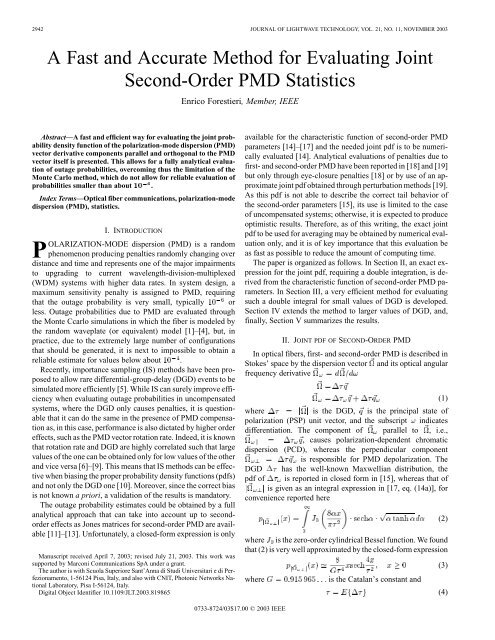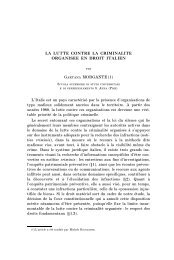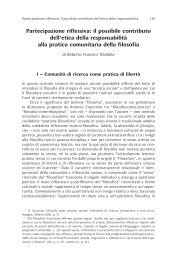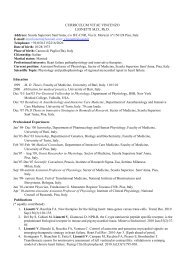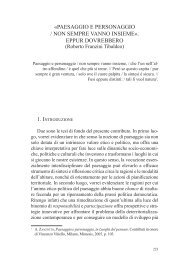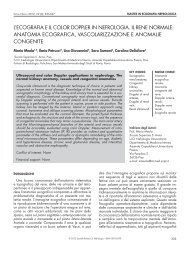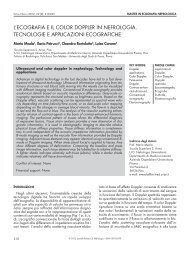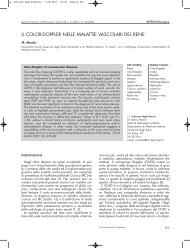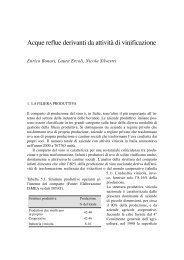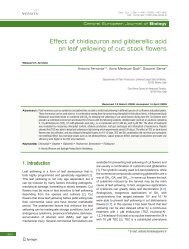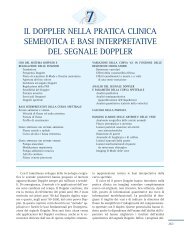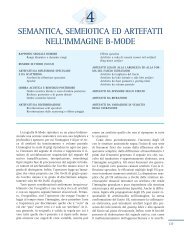A fast and accurate method for evaluating joint second-order PMD ...
A fast and accurate method for evaluating joint second-order PMD ...
A fast and accurate method for evaluating joint second-order PMD ...
You also want an ePaper? Increase the reach of your titles
YUMPU automatically turns print PDFs into web optimized ePapers that Google loves.
2942 JOURNAL OF LIGHTWAVE TECHNOLOGY, VOL. 21, NO. 11, NOVEMBER 2003<br />
A Fast <strong>and</strong> Accurate Method <strong>for</strong> Evaluating Joint<br />
Second-Order <strong>PMD</strong> Statistics<br />
Abstract—A <strong>fast</strong> <strong>and</strong> efficient way <strong>for</strong> <strong>evaluating</strong> the <strong>joint</strong> probability<br />
density function of the polarization-mode dispersion (<strong>PMD</strong>)<br />
vector derivative components parallel <strong>and</strong> orthogonal to the <strong>PMD</strong><br />
vector itself is presented. This allows <strong>for</strong> a fully analytical evaluation<br />
of outage probabilities, overcoming thus the limitation of the<br />
Monte Carlo <strong>method</strong>, which do not allow <strong>for</strong> reliable evaluation of<br />
probabilities smaller than about IH R .<br />
Index Terms—Optical fiber communications, polarization-mode<br />
dispersion (<strong>PMD</strong>), statistics.<br />
I. INTRODUCTION<br />
POLARIZATION-MODE dispersion (<strong>PMD</strong>) is a r<strong>and</strong>om<br />
phenomenon producing penalties r<strong>and</strong>omly changing over<br />
distance <strong>and</strong> time <strong>and</strong> represents one of the major impairments<br />
to upgrading to current wavelength-division-multiplexed<br />
(WDM) systems with higher data rates. In system design, a<br />
maximum sensitivity penalty is assigned to <strong>PMD</strong>, requiring<br />
that the outage probability is very small, typically or<br />
less. Outage probabilities due to <strong>PMD</strong> are evaluated through<br />
the Monte Ccarlo simulations in which the fiber is modeled by<br />
the r<strong>and</strong>om waveplate (or equivalent) model [1]–[4], but, in<br />
practice, due to the extremely large number of configurations<br />
that should be generated, it is next to impossible to obtain a<br />
reliable estimate <strong>for</strong> values below about .<br />
Recently, importance sampling (IS) <strong>method</strong>s have been proposed<br />
to allow rare differential-group-delay (DGD) events to be<br />
simulated more efficiently [5]. While IS can surely improve efficiency<br />
when <strong>evaluating</strong> outage probabilities in uncompensated<br />
systems, where the DGD only causes penalties, it is questionable<br />
that it can do the same in the presence of <strong>PMD</strong> compensation<br />
as, in this case, per<strong>for</strong>mance is also dictated by higher <strong>order</strong><br />
effects, such as the <strong>PMD</strong> vector rotation rate. Indeed, it is known<br />
that rotation rate <strong>and</strong> DGD are highly correlated such that large<br />
values of the one can be obtained only <strong>for</strong> low values of the other<br />
<strong>and</strong> vice versa [6]–[9]. This means that IS <strong>method</strong>s can be effective<br />
when biasing the proper probability density functions (pdfs)<br />
<strong>and</strong> not only the DGD one [10]. Moreover, since the correct bias<br />
is not known a priori, a validation of the results is m<strong>and</strong>atory.<br />
The outage probability estimates could be obtained by a full<br />
analytical approach that can take into account up to <strong>second</strong><strong>order</strong><br />
effects as Jones matrices <strong>for</strong> <strong>second</strong>-<strong>order</strong> <strong>PMD</strong> are available<br />
[11]–[13]. Un<strong>for</strong>tunately, a closed-<strong>for</strong>m expression is only<br />
Manuscript received April 7, 2003; revised July 21, 2003. This work was<br />
supported by Marconi Communications SpA under a grant.<br />
The author is with Scuola Superiore Sant’Anna di Studi Universitari e di Perfezionamento,<br />
1-56124 Pisa, Italy, <strong>and</strong> also with CNIT, Photonic Networks National<br />
Laboratory, Pisa I-56124, Italy.<br />
Digital Object Identifier 10.1109/JLT.2003.819865<br />
Enrico Forestieri, Member, IEEE<br />
0733-8724/03$17.00 © 2003 IEEE<br />
available <strong>for</strong> the characteristic function of <strong>second</strong>-<strong>order</strong> <strong>PMD</strong><br />
parameters [14]–[17] <strong>and</strong> the needed <strong>joint</strong> pdf is to be numerically<br />
evaluated [14]. Analytical evaluations of penalties due to<br />
first- <strong>and</strong> <strong>second</strong>-<strong>order</strong> <strong>PMD</strong> have been reported in [18] <strong>and</strong> [19]<br />
but only through eye-closure penalties [18] or by use of an approximate<br />
<strong>joint</strong> pdf obtained through perturbation <strong>method</strong>s [19].<br />
As this pdf is not able to describe the correct tail behavior of<br />
the <strong>second</strong>-<strong>order</strong> parameters [15], its use is limited to the case<br />
of uncompensated systems; otherwise, it is expected to produce<br />
optimistic results. There<strong>for</strong>e, as of this writing, the exact <strong>joint</strong><br />
pdf to be used <strong>for</strong> averaging may be obtained by numerical evaluation<br />
only, <strong>and</strong> it is of key importance that this evaluation be<br />
as <strong>fast</strong> as possible to reduce the amount of computing time.<br />
The paper is organized as follows. In Section II, an exact expression<br />
<strong>for</strong> the <strong>joint</strong> pdf, requiring a double integration, is derived<br />
from the characteristic function of <strong>second</strong>-<strong>order</strong> <strong>PMD</strong> parameters.<br />
In Section III, a very efficient <strong>method</strong> <strong>for</strong> <strong>evaluating</strong><br />
such a double integral <strong>for</strong> small values of DGD is developed.<br />
Section IV extends the <strong>method</strong> to larger values of DGD, <strong>and</strong>,<br />
finally, Section V summarizes the results.<br />
II. JOINT PDF OF SECOND-ORDER <strong>PMD</strong><br />
In optical fibers, first- <strong>and</strong> <strong>second</strong>-<strong>order</strong> <strong>PMD</strong> is described in<br />
Stokes’ space by the dispersion vector <strong>and</strong> its optical angular<br />
frequency derivative<br />
where is the DGD,<br />
(1)<br />
is the principal state of<br />
polarization (PSP) unit vector, <strong>and</strong> the subscript indicates<br />
differentiation. The component of parallel to , i.e.,<br />
, causes polarization-dependent chromatic<br />
dispersion (PCD), whereas the perpendicular component<br />
DGD<br />
is responsible <strong>for</strong> <strong>PMD</strong> depolarization. The<br />
has the well-known Maxwellian distribution, the<br />
pdf of is reported in closed <strong>for</strong>m in [15], whereas that of<br />
is given as an integral expression in [17, eq. (14a)], <strong>for</strong><br />
convenience reported here<br />
where is the zero-<strong>order</strong> cylindrical Bessel function. We found<br />
that (2) is very well approximated by the closed-<strong>for</strong>m expression<br />
where is the Catalan’s constant <strong>and</strong><br />
(2)<br />
(3)<br />
(4)
FORESTIERI: A FAST AND ACCURATE METHOD FOR EVALUATING JOINT SECOND-ORDER <strong>PMD</strong> STATISTICS 2943<br />
Fig. 1. Pdf of <strong>for</strong> a 15-, 20-, <strong>and</strong> 30-ps mean DGD. Circles are obtained<br />
from (2), <strong>and</strong> solid lines from (3).<br />
where means expectation, is the mean DGD. A comparison<br />
of (2) <strong>and</strong> (3) is shown in Fig. 1.<br />
Even if the pdf of all the quantities appearing in (1) is<br />
known, this is not enough as, <strong>for</strong> averaging, the <strong>joint</strong> pdf<br />
is needed. 1 As <strong>and</strong> is known [14],<br />
we focus on , which is the unknown quantity we need.<br />
Following [15], we let<br />
<strong>and</strong> denote by<br />
the normalized <strong>PMD</strong> vector <strong>and</strong> its derivative, respectively.<br />
Parameter is the st<strong>and</strong>ard deviation of each one of the<br />
components of the dispersion vector . In the reference frame<br />
whose first axis is coincident with , the characteristic function<br />
of the conditional <strong>joint</strong> pdf<br />
of the components 2 is [15]<br />
where<br />
is the three-dimensional (3-D) trans<strong>for</strong>m<br />
variable <strong>and</strong> .<br />
Obtaining a closed-<strong>for</strong>m expression <strong>for</strong> by analytical<br />
inversion of (7) proved to be a <strong>for</strong>midable task, <strong>and</strong> on the other<br />
side, a numerical inversion through a 3-D <strong>fast</strong> Fourier trans<strong>for</strong>m<br />
1For brevity, the pdf arguments are sometimes omitted.<br />
2In the following ‘1“ denotes transpose.<br />
(5)<br />
(6)<br />
(7)<br />
(8)<br />
(FFT) is not feasible as, by simply <strong>and</strong> optimistically using 64<br />
points one-dimensional (1-D) FFTs, a total of about 7 000 000<br />
multiplications should be carried out, which does not exactly<br />
account <strong>for</strong> a <strong>fast</strong> <strong>and</strong> efficient evaluation.<br />
Analytical approximations <strong>for</strong> the <strong>joint</strong> pdf of <strong>and</strong> are<br />
reported in [14] <strong>and</strong> [15], but, even if <strong>second</strong>-<strong>order</strong> moments are<br />
correctly reproduced, they greatly underestimate the tails<br />
<strong>and</strong> there<strong>for</strong>e are not suitable <strong>for</strong> <strong>PMD</strong>-induced penalties evaluation<br />
in compensated systems.<br />
Regarding the inversion of (7), as shown in Appendix A,<br />
after changing to spherical polar coordinates, the<br />
circular symmetry of one of the angle coordinates allows that<br />
angle dimension to be easily integrated in closed <strong>for</strong>m, <strong>and</strong>,<br />
after a suitable trans<strong>for</strong>mation, the <strong>joint</strong> pdf of <strong>and</strong><br />
, conditional upon , can be written as 3<br />
where<br />
(10)<br />
Hence, to evaluate (9), we have to numerically per<strong>for</strong>m a twodimensional<br />
(2-D) integral, but a very difficult one, as both<br />
<strong>and</strong> the integr<strong>and</strong> in (10) have an oscillatory nature.<br />
Indeed, evaluation of through (9) over a grid<br />
of 100 100 points, covering the tails down to about ,<br />
requires from a few hours to several days of computing time<br />
on a <strong>fast</strong> processor, depending on . The higher the value of<br />
with respect to , the lesser the required time to obtain a<br />
prescribed accuracy. The inner integral (10) is the most critical<br />
one, <strong>and</strong> we tried several numerical integration <strong>method</strong>s to<br />
evaluate it, including evaluation through FFT, but the most efficient<br />
turned out to be a recursive one based on the determination<br />
of a set of subintervals , , of (0,1)<br />
such that , , <strong>for</strong> which 8- <strong>and</strong> 16-points Gauss<br />
quadrature <strong>for</strong>mulas give results differing by less than a prescribed<br />
accuracy . Denoting by , the approximate<br />
value of the integral on interval given by the -point<br />
Gauss <strong>for</strong>mula, (10) is approximated as ,<br />
where , <strong>for</strong> ,<br />
<strong>and</strong> are found by the following recursive procedure: i) initially<br />
; ii) <strong>for</strong> , is successively set to<br />
, , until the prescribed<br />
accuracy is attained in ; <strong>and</strong> iii) the procedure completes<br />
when accuracy is obtained <strong>for</strong> .<br />
III. EVALUATING THE JOINT PDF FOR<br />
As already pointed out in Section II, the numerical evaluation<br />
of (9) is not a trivial task. In this section, we will develop a<br />
<strong>method</strong> that turns out to be very efficient in the case<br />
, other than evidencing a key feature of the inner integral<br />
in (10).<br />
3 We moved the conditioning on from the subscript to avoid clutter.<br />
(9)
2944 JOURNAL OF LIGHTWAVE TECHNOLOGY, VOL. 21, NO. 11, NOVEMBER 2003<br />
As shown in Appendix A, the inner integral in (10)<br />
can be evaluated as<br />
where is as in (8), whereas<br />
(11)<br />
(12)<br />
Using the first term only in the series expansion (11), we have<br />
that<br />
<strong>and</strong> substituting (13) in (9) yields<br />
(13)<br />
(14)<br />
We will now show that (14) is a good approximation <strong>for</strong><br />
, meaning that very few terms in (11) are needed to approximate<br />
well when is of the same <strong>order</strong> as . In <strong>order</strong><br />
to do this, we evaluate the approximate marginals<br />
<strong>and</strong> from (14) <strong>and</strong> compare them with the exact<br />
ones. To evaluate the marginal pdf , we integrate (14)<br />
over from to . By per<strong>for</strong>ming the change of variable<br />
, the needed integral can be evaluated with the<br />
aid of [20, eq. 3.753.3]<br />
to yield<br />
(15)<br />
(16)<br />
which turns out to be the exact expression <strong>for</strong> the pdf<br />
[17]. This means that the approximate pdf (14) is already normalized,<br />
i.e., it integrates to 1.<br />
We now evaluate from (14) the marginal pdf<br />
by integrating over from 0 to . Taking<br />
into account that the Fourier trans<strong>for</strong>m of the unit step function<br />
is , by the<br />
change of variable ,wehave<br />
(17)<br />
<strong>and</strong> thus<br />
from which, as ,wehave<br />
whereas the exact expression is [15]<br />
(18)<br />
(19)<br />
(20)<br />
As can be seen, the integr<strong>and</strong>s in (19) <strong>and</strong> (20) differ by the exponential<br />
term , but taking into account (8), <strong>for</strong><br />
, it can be approximated with 1 without significantly affecting<br />
the value of the integral. There<strong>for</strong>e, <strong>for</strong> , the marginals<br />
obtained from (14) are almost exact, <strong>and</strong> thus (14) is a good approximation<br />
to the exact <strong>joint</strong> pdf.<br />
A. Evaluating<br />
In <strong>order</strong> to use (11), we need an explicit expression <strong>for</strong> the<br />
term<br />
(21)<br />
<strong>and</strong> we found several expressions <strong>for</strong> it. Here, we will use the<br />
one that we found most convenient from a numerical point of<br />
view <strong>and</strong> present a less efficient but simpler alternative in Appendix<br />
B.<br />
As shown in Appendix A, (21) can be evaluated through the<br />
finite sum<br />
where<br />
(22)<br />
(23)<br />
with being the Kronecker symbol ( if ,0<br />
otherwise), the integer part of , the Gegenbauer<br />
polynomial of <strong>order</strong> <strong>and</strong> index [21], <strong>and</strong><br />
(24)
FORESTIERI: A FAST AND ACCURATE METHOD FOR EVALUATING JOINT SECOND-ORDER <strong>PMD</strong> STATISTICS 2945<br />
which can also be written in a recursive <strong>for</strong>m, more suitable <strong>for</strong><br />
calculation, as<br />
(25)<br />
The use of makes evaluation of (23) very efficient because<br />
Gegenbauer polynomials satisfy the recurrence relation<br />
[21]<br />
(26)<br />
<strong>and</strong> , <strong>for</strong> any value of . There<strong>for</strong>e, in (23), only<br />
the polynomial corresponding to should be explicitly<br />
evaluated, but this can be done, in turn, through the recurrence<br />
relation [21]<br />
(27)<br />
As all quantities appearing in (22) are easily <strong>and</strong> recursively<br />
evaluated by per<strong>for</strong>ming simple multiplications, it is a very efficient<br />
expression. As an example, taking into account (26) <strong>and</strong><br />
(27), all the Gegenbauer polynomials needed in (23), <strong>for</strong> all<br />
values of , can be obtained with multiplications, at most,<br />
<strong>and</strong> only two multiplications need be per<strong>for</strong>med <strong>for</strong> each to<br />
evaluate <strong>and</strong> through (25) as the required values<br />
<strong>for</strong> <strong>and</strong> are to be evaluated only once. Moreover, notice<br />
that the values in (23) are independent from , <strong>and</strong> thus they<br />
need not be reevaluated when per<strong>for</strong>ming the outer integral with<br />
respect to .<br />
A word of notice is in <strong>order</strong> here about the correct use of the<br />
recurrence relation (25). As, <strong>for</strong> fixed , the sequence<br />
is decreasing in absolute value with , (25) can be safely used in<br />
the <strong>for</strong>ward direction <strong>for</strong> <strong>evaluating</strong> only when ;<br />
otherwise, it becomes unstable. Hence, <strong>for</strong> , (25) is to be<br />
used in the backward direction<br />
(28)<br />
according to the following procedure. As is a decreasing<br />
function of , <strong>for</strong> a sufficiently large value of ,<br />
say , the term becomes negligible<br />
with respect to <strong>and</strong> can be taken equal to<br />
zero. There<strong>for</strong>e, the starting value to be used with (28) can<br />
be taken equal to .<br />
The value of can be readily found in the following<br />
manner. If is to be evaluated <strong>for</strong> ,<br />
with , then initially one takes ,<br />
, <strong>and</strong> applies (28) <strong>for</strong><br />
<strong>evaluating</strong> . Let us refer<br />
to the value obtained in this way as . Then,<br />
the computations are repeated but starting with ,<br />
<strong>and</strong> the resulting value of is compared with the<br />
previous one. If their difference is less than a prescribed<br />
accuracy, say , then<br />
(28) is repeatedly applied until finding ;<br />
otherwise one starts again with <strong>and</strong> so on. We<br />
found that when choosing , only two iterations are<br />
required to achieve ten-significant-digits accuracy on .<br />
Depending on the value of , (28) may lose accuracy <strong>for</strong> the<br />
smaller values of ; there<strong>for</strong>e, <strong>for</strong> better results, one also uses<br />
(25) starting from <strong>and</strong> replacing the corresponding<br />
values obtained through (28) until their absolute difference<br />
keeps decreasing.<br />
For later use, notice that, by using (24) <strong>and</strong> after some algebra,<br />
(22) can be written as<br />
where<br />
(29)<br />
(30)<br />
B. Evaluating the Outer Integral<br />
The expressions previously developed to evaluate the inner<br />
integral in (9) turn out to be useful <strong>for</strong> the evaluation of the outer<br />
integral, as well. Indeed, in [22], it is shown that integrals of<br />
the type , where ,as , tends to a <strong>for</strong>m<br />
that can be written as a steadily decreasing factor times the sum<br />
of a finite number of sinusoidal terms whose periods tend to<br />
constant values, can be very efficiently evaluated by means of<br />
the trapezoidal rule by using a step size close to the shortest<br />
period . The interval is related to the sampling theorem<br />
<strong>for</strong> b<strong>and</strong>-limited functions, <strong>and</strong> the trapezoidal rule can give the<br />
exact value of the integral when the step size is less than some<br />
fixed value [22, p. 709].<br />
Taking into account (11), (29), <strong>and</strong> (30), in (10) can<br />
be written as<br />
where<br />
(31)<br />
(32)
2946 JOURNAL OF LIGHTWAVE TECHNOLOGY, VOL. 21, NO. 11, NOVEMBER 2003<br />
Fig. 2. @&Y Y A <strong>and</strong> @&Y Y A in (32) <strong>for</strong> a aQ<strong>and</strong> 1( a ". Inset<br />
shows s@&Y Y A in (10) (solid line) <strong>and</strong> approximation (13) (circles).<br />
are steadily decreasing functions of , as shown in Fig. 2 <strong>for</strong><br />
<strong>and</strong> . Thus, the integr<strong>and</strong> in (9) is of the<br />
type mentioned previously with , <strong>and</strong> (9)<br />
can be efficiently evaluated by the trapezoidal rule as<br />
(33)<br />
The sum is stopped when becomes negligible while<br />
taking the initial step size as<br />
(34)<br />
<strong>and</strong> successively halving it until the result stabilizes in the desired<br />
number of digits. When halving the step size, the newly<br />
computed values can be simply added to the trapezoidal sum,<br />
<strong>and</strong> the multiplication by the final step size done at the end. We<br />
found that when taking the initial step size as in (34), in the vast<br />
majority of cases, it has to be halved only once to achieve fourdigits<br />
accuracy. By this <strong>method</strong>, evaluation of<br />
over the same grid of 100 100 points previously mentioned requires<br />
only a few tens-of-<strong>second</strong>s computing time <strong>for</strong> ,<br />
with a gain of up to five <strong>order</strong>s of magnitude with respect to<br />
the case in which is evaluated through a numerical<br />
quadrature <strong>method</strong>. The total number of times that in (33)<br />
is to be evaluated <strong>for</strong> four-digits accuracy ranges from ,<br />
<strong>for</strong> low values of <strong>and</strong> ,to <strong>for</strong> the tails down to<br />
about . Correspondingly, evaluation of through<br />
(11) requires less than 25 terms, depending on the<br />
value of , according to the following empirical relation<br />
, where . In Fig. 3(a) <strong>and</strong><br />
(b), the <strong>joint</strong> pdf is shown <strong>for</strong> <strong>and</strong> 2 , respectively,<br />
showing that the conditional variance of ,<br />
the normalized component of parallel to , is constant, its<br />
value being as known [15]. In Fig. 4, ,<br />
evaluated through (33), is plotted <strong>for</strong> 2 as a function of<br />
<strong>for</strong> several values of in (a), <strong>and</strong> as a function of <strong>for</strong> several<br />
values of in (b). Circles represents values obtained through<br />
numerical integration of (10) as previously explained, whereas<br />
solid lines are obtained by using (11).<br />
IV. EVALUATION OF THE JOINT PDF FOR 2<br />
When the DGD becomes progressively larger than , the<br />
value of in (8) also increases <strong>and</strong> a larger number of terms<br />
would be required to evaluate through (11). This is a<br />
problem as, when <strong>evaluating</strong> (21) through (22), the term<br />
assumes values increasing with <strong>and</strong>, having the terms in<br />
(22) alternate signs, this causes too much cancellation <strong>for</strong> larger<br />
values of or , preventing evaluation of (21) with the required<br />
accuracy. We found that evaluation of through (11)<br />
<strong>and</strong> (22) is always safe <strong>for</strong> 2 , but we need alternative<br />
ways when 2 .<br />
We discovered several exact expansions <strong>for</strong> in (10),<br />
but none of them turned out to be usable <strong>for</strong> all possible values<br />
of parameters in (8) <strong>and</strong> <strong>and</strong> in (12) without incurring<br />
in numerical problems similar to those discussed about (22).<br />
Instead, it is possible to develop an approximate expansion <strong>for</strong><br />
that is always valid whatever the value of , <strong>and</strong><br />
. The key to this expansion is an approximate expansion <strong>for</strong><br />
the term in terms of hyperbolic cosines. We start by<br />
taking the Fourier trans<strong>for</strong>m of ,<br />
where is the unit step function. By completing the square<br />
in the exponent, the result is <strong>for</strong>mally simple<br />
(35)<br />
where is the complex error function.<br />
We now use an infinite series approximation <strong>for</strong> the complex<br />
error function, whose relative error is [21, eq. 7.1.29],<br />
to write<br />
<strong>and</strong> antitrans<strong>for</strong>ming back, we obtain<br />
(36)<br />
(37)<br />
with a relative error of <strong>for</strong> all values of . This means<br />
that in a double-precision arithmetic (37) is virtually exact. As<br />
an example, <strong>for</strong> ,wehave<br />
double precision<br />
quadruple precision.
FORESTIERI: A FAST AND ACCURATE METHOD FOR EVALUATING JOINT SECOND-ORDER <strong>PMD</strong> STATISTICS 2947<br />
Fig. 3. Joint pdf @Y A <strong>for</strong> (a) 1( a " <strong>and</strong> (b) 1( a 2". Contours are at IH , aIY PY FFFY IS.<br />
By using [21, eq. 10.1.48], we also have that<br />
(38)<br />
where are the spherical Bessel<br />
functions of the first kind. Substituting (37) <strong>and</strong> (38) in (10), we<br />
obtain<br />
where<br />
(39)<br />
(40)<br />
may be evaluated with the aid of [20, eq. 7.322]. 4 By using [21,<br />
eq. 10.1.45], (39) can be written as<br />
4 Notice that a factor 2 is missing in the result in [20, eq. 7.322].<br />
(41)<br />
<strong>and</strong>, taking the principal value, the square root appearing in (41)<br />
is equal to<br />
where<br />
so that (41) becomes<br />
(42)<br />
(43)<br />
(44)<br />
(45)<br />
.<br />
This is the expression to be used <strong>for</strong> <strong>evaluating</strong> the <strong>joint</strong> pdf<br />
when 2 . Notice that (45) could also be used <strong>for</strong><br />
2 , but, in this case, (11) turns out to be <strong>fast</strong>er. This is because<br />
in (45) the various elementary functions must be reevaluated <strong>for</strong><br />
each term in the series, whereas (22) only requires the evaluation<br />
of a few terms through simple recurrence relations, as already<br />
discussed. For larger values of , however, (11) would require
2948 JOURNAL OF LIGHTWAVE TECHNOLOGY, VOL. 21, NO. 11, NOVEMBER 2003<br />
Fig. 4. Joint pdf @Y A (a) as a function of <strong>for</strong><br />
a RY TY FFFY IT <strong>and</strong> (b) as a function of <strong>for</strong> a HY PY FFFY IH <strong>and</strong><br />
1( a 2", evaluated through (33). Circles are obtained through numerical<br />
integration of (10), solid lines by using (11).<br />
more terms than those needed in (45), which in most cases are<br />
in the <strong>order</strong> of to achieve the necessary precision. Also<br />
notice that the major contribution does not necessarily come<br />
from the first terms. Indeed, rewriting (45) as<br />
(46)<br />
where , <strong>and</strong> taking into account that, <strong>for</strong> increasing<br />
values of , in (44) asymptotically tends to ,<br />
i.e., , we also have that<br />
, so that, in many cases, the most important<br />
terms are those <strong>for</strong> in the <strong>order</strong> of , or slightly less.<br />
Using (45), evaluation of (33) <strong>for</strong> the larger values of turns<br />
out to be about an <strong>order</strong> of magnitude slower than using (11)<br />
<strong>for</strong> the smaller values. For the larger values, evaluation<br />
of (33) through numerical integration of (10) turns out to<br />
be about an <strong>order</strong> of magnitude <strong>fast</strong>er than <strong>for</strong> the smaller<br />
values. There<strong>for</strong>e, using (45) <strong>for</strong> <strong>evaluating</strong> (33) is about<br />
<strong>order</strong>s of magnitude <strong>fast</strong>er than using the integration <strong>method</strong><br />
described at the end of Section II <strong>and</strong> even much <strong>fast</strong>er with<br />
respect to other st<strong>and</strong>ard numerical integration <strong>method</strong>s. However,<br />
we point out that this discussion applies only when considering<br />
values <strong>for</strong> the <strong>joint</strong> pdf not smaller than about ;<br />
otherwise st<strong>and</strong>ard numerical integration <strong>method</strong>s slow down<br />
Fig. 5. Joint pdf @Y A (a) as a function of <strong>for</strong><br />
a RY VY FFFY PV <strong>and</strong> (b) as a function of <strong>for</strong> a HY PY RY FFFY IH<br />
<strong>and</strong> 1( a 5", evaluated through (33). Circles are obtained through numerical<br />
integration of (10), <strong>and</strong> solid lines by using (45).<br />
considerably, <strong>and</strong> the values they provide are not reliable (as<br />
the curves become jagged <strong>and</strong> sometimes negative values are<br />
returned), whereas the <strong>method</strong>s presented in this <strong>and</strong> Section III<br />
do not suffer any slow down <strong>and</strong> can give reliable values down<br />
to about , i.e., the machine precision in IEEE St<strong>and</strong>ard<br />
754 double-precision arithmetic.<br />
In Fig. 5, , evaluated using (45) in (33), is<br />
plotted <strong>for</strong> 5 as a function of <strong>for</strong> several values of in<br />
(a), <strong>and</strong> as a function of <strong>for</strong> several values of in (b). Again,<br />
circles represents values obtained through numerical integration<br />
of (10).<br />
V. SUMMARY AND CONCLUSION<br />
The exact evaluation of the <strong>joint</strong> pdf of <strong>and</strong> , conditional<br />
upon , can only be per<strong>for</strong>med by numerical <strong>method</strong>s,<br />
<strong>and</strong>, to this end, the double-integral <strong>for</strong>mula (9) has been devised.<br />
It has been shown that the inner integral (10) has an<br />
analytic expression that can be exploited <strong>for</strong> a really efficient<br />
evaluation of the outer integral in (9) through (33), practically<br />
equivalent to a series expansion, as the step size (34) is to be<br />
halved only once in about 90% of cases, on average, to achieve<br />
four-digits accuracy when <strong>evaluating</strong> in (10) with sufficient<br />
accuracy; indeed, the fact that the step size is to be halved<br />
more than once may be taken as an indication of poor accuracy<br />
on .
FORESTIERI: A FAST AND ACCURATE METHOD FOR EVALUATING JOINT SECOND-ORDER <strong>PMD</strong> STATISTICS 2949<br />
Evaluation of the inner integral in (10) is the most<br />
critical, as it is to be evaluated with very high accuracy <strong>for</strong> the<br />
tails of the <strong>joint</strong> pdf, <strong>and</strong> we had to use a value <strong>for</strong> accuracy<br />
as small as in the numerical integration <strong>method</strong> described<br />
at the end of Section II to obtain reliable values down to<br />
. We also noticed that the higher the accuracy in <strong>evaluating</strong><br />
, the lesser the number of times that step size<br />
in (33) is to be halved to achieve a given number of reliable<br />
digits <strong>for</strong> the <strong>joint</strong> pdf. The very high accuracy needed <strong>for</strong><br />
is easily <strong>and</strong> efficiently achieved through the expansions<br />
reported in Sections II–IV. Until a closed-<strong>for</strong>m expression<br />
is not available, a <strong>fast</strong> <strong>and</strong> <strong>accurate</strong> <strong>method</strong> <strong>for</strong> <strong>evaluating</strong> the<br />
<strong>joint</strong> <strong>second</strong>-<strong>order</strong> <strong>PMD</strong> statistics is a prerequisite <strong>for</strong> a full analytical<br />
evaluation of the <strong>PMD</strong> impact on the per<strong>for</strong>mance of<br />
compensated systems <strong>and</strong> may also be a useful tool <strong>for</strong> validating<br />
IS techniques (see Appendix C).<br />
APPENDIX A<br />
In this appendix, we show the derivation of (9), (11), <strong>and</strong> (22)<br />
mentioned in the paper. The exact expression <strong>for</strong><br />
can be obtained by direct antitrans<strong>for</strong>mation of (7) as<br />
(A1)<br />
where is as in (8). Changing to spherical polar coordinates<br />
yields<br />
(A2)<br />
<strong>and</strong> the integral with respect to is easily per<strong>for</strong>med, yielding<br />
(A3)<br />
From (A3), we obtain the <strong>joint</strong> pdf of <strong>and</strong><br />
as<br />
(A4)<br />
from which, by the change of variable <strong>and</strong> after some<br />
algebra, we obtain (9).<br />
By using the expansion , the integral<br />
in (10) can be evaluated as<br />
Letting <strong>and</strong> as in (12), we start from [20, eq. 6.677.6]<br />
<strong>and</strong>, by repeated differentiation with respect to , obtain<br />
(A5)<br />
(A6)<br />
(A7)<br />
which, substituted in (A5), gives (11).<br />
Thus, we simply need an explicit expression <strong>for</strong> the<br />
right-h<strong>and</strong>-side term in (A7). To obtain it, we use the rule<br />
<strong>for</strong> the th derivative of a composite function. Letting<br />
(such that ), if<br />
, then [20]<br />
where<br />
(A8)<br />
(A9)<br />
Given , where<br />
, , we apply the previous rule<br />
to obtain the th derivative of as<br />
where<br />
By using the <strong>for</strong>mula [20]<br />
(A10)<br />
(A11)<br />
(A12)<br />
where denotes the Pochhammer’s symbol, defined as [21]<br />
(A13)
2950 JOURNAL OF LIGHTWAVE TECHNOLOGY, VOL. 21, NO. 11, NOVEMBER 2003<br />
being the Gamma function, it is easy to show that<br />
(A14)<br />
in which we can recognize the Gegenbauer polynomial of <strong>order</strong><br />
<strong>and</strong> index as<br />
so that<br />
(A15)<br />
(A16)<br />
Letting <strong>and</strong> substituting (A16) in (A11), we obtain<br />
(A17)<br />
where we made the change of variable . Taking now<br />
into account the fact that<br />
(A17) can also be written as<br />
<strong>and</strong> substituting (A19) in (A10), we obtain (22).<br />
(A18)<br />
(A19)<br />
APPENDIX B<br />
As already said, we found several different expansions <strong>for</strong><br />
<strong>evaluating</strong> (21), <strong>and</strong> in this appendix, we report the one that<br />
turned out to be the most competitive with (22). Thus, somewhat<br />
sacrificing per<strong>for</strong>mance, it could be used as an alternative to<br />
(22). For the sake of brevity, we will only report a trace of the<br />
full proof.<br />
It is easy to show that the relation [21, eq. 10.1.24]<br />
also holds <strong>for</strong><br />
i.e.,<br />
<strong>and</strong>, using (B3), by induction, we have<br />
. . .<br />
.<br />
..<br />
Taking now into account that<br />
, we obtain<br />
(B1)<br />
(B2)<br />
(B3)<br />
(B4)<br />
The spherical Bessel functions needed in (B4) can be efficiently<br />
evaluated by a simple recurrence relation [21] or through<br />
one of the many available subroutines <strong>for</strong> <strong>evaluating</strong> the cylindrical<br />
functions of fractional <strong>order</strong> . Although more compact<br />
than (22), we found that (B4) is less efficient than it when<br />
used in (11) <strong>for</strong> <strong>evaluating</strong> (33).<br />
APPENDIX C<br />
A <strong>fast</strong> <strong>and</strong> <strong>accurate</strong> <strong>method</strong> <strong>for</strong> the evaluation of the <strong>joint</strong> pdf<br />
is also useful <strong>for</strong> validating other techniques used <strong>for</strong> outage<br />
probabilities estimation. In this appendix, we apply the <strong>method</strong>s<br />
previously developed to evaluate the <strong>joint</strong> pdf of <strong>and</strong><br />
<strong>and</strong> compare it with the <strong>joint</strong> pdf obtained numerically through<br />
IS in [10] <strong>and</strong> [23].<br />
As known [24], the <strong>joint</strong> pdf of <strong>and</strong>5 , where <strong>and</strong> have <strong>joint</strong> pdf ,<br />
is , <strong>and</strong> the marginal pdf<br />
<strong>for</strong> can be obtained as . There<strong>for</strong>e,<br />
5 The —— function is taken to return values between 0 <strong>and</strong> %.
FORESTIERI: A FAST AND ACCURATE METHOD FOR EVALUATING JOINT SECOND-ORDER <strong>PMD</strong> STATISTICS 2951<br />
letting , , <strong>and</strong> taking into account (9), it can<br />
be shown that<br />
where<br />
(C1)<br />
(C2)<br />
(C3)<br />
By the change of variable <strong>and</strong> using [20, eq. 6.677.6],<br />
in (C3) can be integrated in closed <strong>for</strong>m, <strong>and</strong> we see that it is<br />
independent from<br />
Substituting (C4) in (C2) <strong>and</strong>, in turn, this in (C1), we obtain<br />
where<br />
(C4)<br />
(C5)<br />
(C6)<br />
is as in (45) <strong>for</strong> , i.e., . Multiplying<br />
(C5) by the Maxwellian pdf finally gives<br />
(C7)<br />
where the integral can be evaluated as done in (33) with an initial<br />
step size of .<br />
Fig. 6 shows contour plots of the denormalized <strong>joint</strong> pdf<br />
(C8)<br />
<strong>for</strong> 3.257 ps, evaluated through (C7), <strong>and</strong> should be<br />
compared with Fig. 4 in [23], reporting the same quantity at the<br />
Fig. 6. Contour plots of the <strong>joint</strong> pdf of <strong>and</strong> <strong>for</strong> a mean DGD of<br />
3.257 ps. Starting from the inner, the contours are at IH with a 1.5, 1.75,<br />
2, 2.25, 2.5, 3, 4, 5, 6, 8, 10, 15, 20, 25, <strong>and</strong> 30.<br />
same contour levels. A close examination reveals that the accordance<br />
is excellent until , but afterwards, the <strong>joint</strong> pdf<br />
obtained through IS starts underestimating the true pdf progressively<br />
more as the contour level lowers. The contours below<br />
in Fig. 6 required quadruple precision to be computed<br />
(notice that (C6) can be used <strong>for</strong> values smaller than when<br />
using a higher precision arithmetic, but only about the first 16<br />
significant digits are correct).<br />
REFERENCES<br />
[1] C. D. Poole <strong>and</strong> D. L. Favin, “Polarization-mode dispersion measurements<br />
based on transmission spectra through a polarizer,” J. Lightwave<br />
Technol., vol. 12, pp. 917–929, June 1994.<br />
[2] D. Marcuse, C. R. Menyuk, <strong>and</strong> P. K. Wai, “Application of the manakov-<strong>PMD</strong><br />
equation to studies of signal propagation in optical fibers<br />
with r<strong>and</strong>omly varying birefringence,” J. Lightwave Technol., vol. 15,<br />
pp. 1735–1746, Sept. 1997.<br />
[3] R. Khosravani Jr, I. T. Lima, P. Ebrahimi, E. Ibragimov, A. E. Willner,<br />
<strong>and</strong> C. R. Menyuk, “Time <strong>and</strong> frequency domain characteristics of polarization-mode<br />
dispersion emulators,” IEEE Photon. Technol. Lett., vol.<br />
13, pp. 127–129, Feb. 2001.<br />
[4] A. O. Dal Forno, A. Paradisi, <strong>and</strong> J. P. von der Weid, “Experimental <strong>and</strong><br />
theoretical modeling of polarization-mode dispersion in single-mode<br />
fibers,” IEEE Photon. Technol. Lett., vol. 12, pp. 296–298, Mar. 2000.<br />
[5] G. Biondini, W. L. Kath, <strong>and</strong> C. R. Menyuk, “Importance sampling <strong>for</strong><br />
polarization-mode dispersion,” IEEE Photon. Technol. Lett., vol. 14, pp.<br />
310–312, Mar. 2002.<br />
[6] B. L. Heffner, “Accurate, automated measurement of differential group<br />
delay dispersion <strong>and</strong> principal state variation using Jones matrix eigenanalysis,”<br />
IEEE Photon. Technol. Lett., vol. 5, pp. 814–817, July 1993.<br />
[7] L. M. Gleeson, E. S. R. Sikora, <strong>and</strong> M. J. O. Mahoney, “Experimental<br />
<strong>and</strong> numerical investigation into the penalties induced by <strong>second</strong> <strong>order</strong><br />
polarization mode dispersion at 10 Gb/s,” in Proc. ECOC’97, vol. 1,<br />
1997, pp. 15–18.<br />
[8] D. Penninckx <strong>and</strong> F. Bruyère, “Impact of the statistics of <strong>second</strong>-<strong>order</strong><br />
polarization-mode dispersion on systems per<strong>for</strong>mance,” in OFC’98<br />
Tech. Dig., 1998, Paper ThR2, pp. 340–342.<br />
[9] L. E. Nelson, R. M. Jopson, H. Kogelnik, <strong>and</strong> G. J. Foschini, “Measurement<br />
of depolarization <strong>and</strong> scaling associated with <strong>second</strong>-<strong>order</strong> polarization<br />
mode dispersion in optical fibers,” IEEE Photon. Technol. Lett.,<br />
vol. 11, pp. 1614–1616, Dec. 1999.<br />
[10] S. L. Fogal, G. Biondini, <strong>and</strong> W. L. Kath, “Multiple importance sampling<br />
<strong>for</strong> first- <strong>and</strong> <strong>second</strong>-<strong>order</strong> polarization-mode dispersion,” IEEE Photon.<br />
Technol. Lett., vol. 14, pp. 1273–1275, Sept. 2002.<br />
[11] A. Eyal, W. K. Marshall, M. Tur, <strong>and</strong> A. Yariv, “Representation of<br />
<strong>second</strong>-<strong>order</strong> polarization mode dispersion,” Electron. Lett., vol. 35,<br />
no. 19, pp. 1658–1659, 1999.<br />
[12] H. Kogelnik, L. E. Nelson, J. P. Gordon, <strong>and</strong> R. M. Jopson, “Jones matrix<br />
<strong>for</strong> <strong>second</strong>-<strong>order</strong> polarization mode dispersion,” Opt. Lett., vol. 25, no.<br />
1, pp. 19–21, 2000.
2952 JOURNAL OF LIGHTWAVE TECHNOLOGY, VOL. 21, NO. 11, NOVEMBER 2003<br />
[13] E. Forestieri <strong>and</strong> L. Vincetti, “Exact evaluation of the jones matrix of a<br />
fiber in the presence of polarization mode dispersion of any <strong>order</strong>,” J.<br />
Lightwave Technol., vol. 17, pp. 1898–1909, Dec. 2001.<br />
[14] G. J. Foschini <strong>and</strong> C. D. Poole, “Statistical theory of polarization<br />
dispersion in single mode fibers,” J. Lightwave Technol., vol. 9, pp.<br />
1439–1456, Nov. 1991.<br />
[15] G. J. Foschini, R. M. Jopson, L. E. Nelson, <strong>and</strong> H. Kogelnik, “The statistics<br />
of <strong>PMD</strong>-induced chromatic fiber dispersion,” J. Lightwave Technol.,<br />
vol. 17, pp. 1560–1565, Sept. 1999.<br />
[16] G. J. Foschini, L. E. Nelson, R. M. Jopson, <strong>and</strong> H. Kogelnik, “Probability<br />
densities of <strong>second</strong>-<strong>order</strong> polarization mode dispersion including polarization<br />
dependent chromatic fiber dispersion,” IEEE Photon. Technol.<br />
Lett., vol. 12, pp. 293–295, Mar. 2000.<br />
[17] , “Statistics of <strong>second</strong>-<strong>order</strong> <strong>PMD</strong> depolarization,” J. Lightwave<br />
Technol., vol. 19, pp. 1882–1886, Dec. 2001.<br />
[18] F. Bruyére, “Impact of first- <strong>and</strong> <strong>second</strong>-<strong>order</strong> <strong>PMD</strong> in optical digital<br />
transmission systems,” Optic. Fiber Technol., vol. 2, pp. 269–280, 1996.<br />
[19] H. Bülow, “System outage probability due to first- <strong>and</strong> <strong>second</strong>-<strong>order</strong><br />
<strong>PMD</strong>,” IEEE Photon. Technol. Lett., vol. 10, pp. 696–698, May 1998.<br />
[20] I. S. Gradshteyn <strong>and</strong> I. M. Ryzhik, Table of Integrals, Series, <strong>and</strong> Products.<br />
San Diego, CA: Academic, 1992.<br />
[21] M. Abramowitz <strong>and</strong> I. A. Stegun, H<strong>and</strong>book of Mathematical Functions.<br />
New York: Dover, 1972.<br />
[22] S. O. Rice, “Efficient evaluation of integrals of analytic functions by<br />
the trapezoidal rule,” Bell Syst. Tech. J., vol. 52, no. 5, pp. 707–722,<br />
May–June 1973.<br />
[23] S. L. Fogal, G. Biondini, <strong>and</strong> W. L. Kath, “Multiple importance sampling<br />
<strong>for</strong> first- <strong>and</strong> <strong>second</strong>-<strong>order</strong> polarization-mode dispersion,” IEEE Photon.<br />
Technol. Lett., vol. 14, p. 1487, Oct. 2002.<br />
[24] A. Papoulis, Probability, R<strong>and</strong>om Variables, <strong>and</strong> Stochastic Processes.<br />
New York: McGraw-Hill, 1991.<br />
Enrico Forestieri (S’91–M’92) was born in Milazzo, Italy, in 1960. He received<br />
the Dr. Ing. degree in electronics engineering from the University of Pisa, Pisa,<br />
Italy, in 1988.<br />
From 1989 to 1991, he was a Postdoctoral Scholar at the University of Parma,<br />
Parma, Italy, working in optical communication systems. From 1991 to 2000,<br />
he was a Research Scientist <strong>and</strong> Faculty Member of the University of Parma.<br />
He is now Associate Professor of Telecommunications at the Scuola Superiore<br />
Sant’Anna, Pisa, Italy. His research interests are in the area of digital communication<br />
theory <strong>and</strong> optical communication systems.


